Komodo
Flying from Bali to Flores is breathtaking— the ocean bursts with islands and phenomena like Mt. Rinjani on Lombok (the second highest volcanic crater in Indonesia, its brim filled with lakes). We arrive at one small terminal with a surprisingly large runway (proof, as we saw everywhere, of the economic boom in Flores). We walk through the single doorway into the terminal and wait for our bags to be carried inside. Immediately cigarette smoking Indonesians barter taxis price with us. 100,000rp offers one cab driver; E laughs outloud. A few yards down, we are offered a ride in a bemo (a small, normally green bus that loosely has a required route); 20,000rp for all four of us.
- Boy lifting bags onto bemo.
The bemo takes us through Labuan Bajo, a dusty, frontier-feeling town, to the dive shop where we meet E’s friend Ed. Ed is tall for an Indonesian with slightly graying hair and a warm smile; he and E worked together here five years ago. Ed takes us to a snorkel rental place; Em & J are fitted (E already has his own), but I have such small feet none of their fins work. “She has Indonesian feet,” they laugh. They will give a pair to the boat captain in the morning.
Then Ed introduces us to our captain; a short man with the demeanor of a pirate. He has an inherent inability to be ruffled, which may belong to all men of the sea. What is human interaction when you’ve withstood squalls? He will pick us up tomorrow on Pungu, a small island forty-five minutes off Flores, which E’s company uses as an oyster grow-out site.
Then we meet Ir, Pungu’s manager. He is quiet, mild-mannered with a quick, sharp look and an obvious ability to understand much more English than he speaks. We wait for the bemo driver to bring back final supplies, standing on the dock until the unrelenting pulse of the midmorning sun is too much.
- the bay
“How long will it be?” I ask E. He laughs. “You know; it’s Indonesia. It could be 5minutes or 5 hours.” Em spots shade nearby, and we go crowd under it, watching men weld iron for the dock expansion, kids gather plastic trash to trade for money.
Finally, the motorboat takes us out of Flores’ small bay and onto the open ocean. Ahead there is a vast expanse dotted with small islands and a handful of boats fishing or transporting people from one location to another.
Pungu is beautiful. It is tiny with eight nicely constructed bamboo houses lining the shore behind the kitchen and dinning room that jut out onto the water. There are buoys placed periodically where oyster lines hang and a large cleaning boat for the daily lifting and scrubbing of different lines required to keep the animals healthy.
Ir is a superb host. He has outfitted a house specifically for our arrival: four, brand-new, twin mattresses, new sheets and toilet paper. As we await lunch, the staff brings a thermos of hot water, coffee, tea, sugar, & mugs. A lovely afternoon treat. As we sip tea, we hear a huge heard of goats. We watch old, bearded goats and the tiny kids tottering after their moms. They are all sure-footed on rocky outcrops, just like mountain goats back home, but with the colors I associate with cows: swirling brown, white and black.
And then there is lunch: delicious cabbage and carrots, freshly grilled fish, tofu. We eat heartily and nap.
When I wake, I walk a path past the other houses and to the shore where I sit, meditating, reading, drinking in all this ocean.
When I return, Em & J are geared up for snorkeling. I change. Near the beach, in the tidal pools, there is mostly sand and swaying plants, but as we go out further, the numbers of fish multiply, and there is all this healthy sea life. I swim over a huge sea snake, its body mostly wrapped, huge and thick, around seaweed. I know they are not dangerous unless provoked, but seeing one just below makes me turn back to shore. All the crazy things that live under the surface of the water…
E pushes for a sunset hike. It is rocky & slick, but after a short ascent, we see the ocean stretching in all directions. It drives home how tiny Pungu is. The sun sets. Goats hike. I become viscerally aware of what I have known intellectually: Indonesia is a chain of islands that stretch an incredible distance. Being on Bali, you see ocean, but there is not a sense of being a part of a chain of little islands in this huge country.
On the boat the next day, looking at all these uninhabited mountains rising dramatically from the ocean, I think about the difference between the ways I love this place and the mountains back home. I realize at home all this water would be valleys and have a surreal sense of connectedness between two worlds.
Waiting for dinner back on our balcony, Ir brings five cans of Bintang. It is such a sweet and generous gesture on this island with no beer, and we each enjoy one, lukewarm and perfect in the rising darkness. A fire is lit near the kitchen to grill the fish Ir caught for dinner. We watch it roast, witness the dramatic shift of low tide (water barely covering the furthest points we snorkeled hours earlier). In the distance, the lights of Labuan Bajo. And so many southern hemisphere stars it takes away the breath.
Our boat arrives at 8am, and Ir wishes us well, helping load bags. Talking with him and finding out he is from Java, I am again aware of Indonesia as a collection of islands, as a transient population of sea people. Bali is an island devoted to its own identity– its own reverence of its own land. Most Balinese I meet have never been off the island. I had an inaccurate sense of Indonesia as a series of isolated places. I now see Bali as the exception rather than the rule, that these islands have given birth to nomadic people who somehow, which I ponder as we motor from Pungu into the expansive stretch of islands and ocean with our Indonesian flag flying proudly, has a sense of national identity.
Two hours later, we arrive at our first Komodo island: Rinca. We hike to the ranger station, where we pay entry fees (5,000rp with a work VISA, 50,000rp without) and are connected with a guide bearing a large, forked stick. The sticks are to push the necks or heads of dragons that aggressively approach. As we start out, we find five dragons (from a foot to six in length) lazing in the mid day sun under the park kitchen. The rangers do not feed them, but the komodo dragons, like snakes, use their tongues to track smells, so they end up congregated under the kitchen. *Only one dragon they feed, a large male that injured his leg fighting for breeding dominance last year. The guide indicates him and explains, “He has a broken leg,” he turns to look at us, face dropping, “and a broken heart”. This must be one of his favorite jokes, because he repeats it a few more times to make sure it sinks in.*
*As we head out of the ranger camp into the dryland jungle,* our guide shares that yesterday a fellow guide was bitten by a dragon; it rushed him from the bushes. Komodos are not poisonous, but they have over fifty strains of bacteria in their mouths, which immediately start to rot away flesh and cause disease. Komodos are normally slow, lumbering creatures that walk like doping weight lifters. They hunt by laying in wait for prey near watering holes. When prey gets close, komodos sprint at twenty miles per hour, delivering a slowly fatal bite. The water buffalo or deer limp away as the dragon follows in the distance, smelling its dying prey. Yesterday’s unlucky guide was put on a boat to Labuan Bajo and then a flight to Bali, the only place the required medicines are available.
In America, the medications would be nearby, ready to administer. But in America, too, there is no way this hike would happen. A guide with a forked stick leading tourists through an area where it is entirely possible a large lizard could attack from the bushes? No way. I pick up a stick just in case. Want to give myself a fighting chance, since I suck at climbing trees.
Dragons, when they are born, are in immediate danger of being eaten by just about everything, including their parents, so they have the evolutionary ability to climb trees. They keep this ability until they are about three years old, and then they become too large to climb, growing into the massive land animals with which we are familiar.
After saying goodbye to our guide at the ranger station, on our ¼ of mile walk back to the boat, we pause on a small bridge to watch fish in a tiny creek and mudskippers(fish with legs). As we stand taking pictures and talking near some European tourists, the girl asks, “Do you see the dragon?” We look up and realize that one is lumbering out of the woods towards us, probably headed to the kitchen to join his fellow lizards in wait. “Jesus,” says J, “It’s funny how when we said goodbye to our guide, it was like walking out of an amusement park. Like ‘oh, the rides over; let’s go back to the car’ and an immediate sense of safety descended. When really, I should be more scared right now. I don’t have a large forked stick or a guide.” We walk quickly back to our boat.
On board, the captain and his crew member somehow managed, on a single burner, to create a feast: tofu and fish in sauce, stewed vegetables, rice, noodles, and sliced cucumbers. We enjoy our meal while speeding across the ocean.
Next we stop at Pink Beach for snorkeling. It is one of the conservation successes in Komodo. Instead of dropping anchor, our captain ties to an existing buoy. My fins have not arrived, but the water is calm and the coral breathtakingly amazing: the most healthy, undamaged coral I have seen. Diverse and vibrant schools of fish swim throughout the reef. *Parrot fish, surgeonfish, trigger and puffer fish. Serpentine pipefish with long stem-like jaws and a tiny mouth. Wrasses darting in and out of the gaps in the corals. Clownfish hiding in the protective custody of anemones. Small grouper warily keep their distance.* Em even sees a manta ray. Pink Beach is so named because of the red coral that breaks down naturally and coats the beach with a pink hue.
By the time we redock, a canoe had pulled up with a man selling wares. Pearl necklaces, carved wooden dragons. Are we interested? Em likes a pearl necklace, which E & the seller confirmed to be legitimate. She is the shrewdest barter I have ever seen in action. She decides on a price and is unwilling to budge. So either she walks (or in this case, he would untie his canoe from our boat) or they bite. As he leaves, Emily wearing her necklace, he says to E, “She is really good at that.”
Motoring to our next location, a school of dolphins come into view. We anchor for the night, dolphins dancing on the horizon as the sun starts to set. E and J take turns on the SUP around the nearby island, E catching up with the dolphins, hoping they will play, but finding them intent on catching fish.
Dinner is the same delicious meal, complimented by Bintang besar. E gets the wild idea to go out SUPing in the dark, which we think is a terrible idea. When he comes back, he describes all the bioluminescence. Anybody else? I put on my swimsuit.
Paddling away from the ship in the dark is a terrifying moment: alone in the thick of night on an ocean far from home. When I escape the boat’s light, I see the bioluminescence; it is magical. I paddle, watching the brilliant green swirl, and then just stop, kneel down, and move the water with my hand. It is a transcendent experience.
J goes next and comes back radiant. We talk and laugh until late, and then make our beds (sheets over mats on the deck). For the first time in my life, I fall asleep on the rocking of the ocean.
We wake at 3:30am to rain. Pull down tarps draped from the roof and lashed to posts. It is an arduous experience; even after the rain had stopped, the first mate is still on the side of the boat with his flashlight between his teeth, tying up the tarp.
I cannot get back to sleep and lay listening to the rain. The rocking of the boat. My friend’s dreams. When first light hits, I rise and sit on the banister, watching the nearby island where flying foxes call and circle. E wakes, “You want to paddle?”
As the sun rises, I glide over clear, coral rich waters around an island where flying foxes swoop, watching fish dive and rise. I see something five or six feet in length. ‘Is that a harmless fish or shark?’ I think.
I return in time for noodles, and we are off, motoring along the edge of Komodo. The sky is perfectly overcast. Our new guide again warns us of the attack two days before, and then we are off.
Immediately, we spot deer. The jungle is thicker, more lush than yesterday. Around a corner, we stumble upon a huge komodo six feet or so in length. We stop to take pictures, and I pick up a stick. Knowing how fast they can dash, the guide’s lackadaisical relationship with it makes me keep a wary eye.
As we rise out of the forest, cockatoos sing across the morning sky. Komodo Island is home to over 150 species of birds.
I move to the front and start to talk to the guide in Indonesian. At some points, I lose the details of the conversation and only understand the ideas, but it is lovely. Guide, stick in hand, black bird with a yellow breast swooping over, and us communicating in his native tongue.
After our tour, we walk by myriad stalls, pedaling identical wares. In this din, a man E used to work with in Flores five years ago spots him. They embrace warmly.
Back on the boat, we make our way to where the manta rays often are (you can jump in and snorkel along the current with them for awhile, and then the boat will pick you up, depositing you at another twist the mantas have taken to continue to swim with them), the waves grow large and choppy. The boat seems to rock almost horizontally. We watch the captain. If he shows any fear, we know to move closer to the SUP and prepare to grab hold of it as a flotation device, but he stays stoic, calm.
We did not spot any mantas, but the captain drops anchor and invites us to get in and snorkel. The current is strong, and I was without flippers, so even as I get in and try to swim away from the boat, I find myself in all-out crawl stroke (arms and legs pushing), barely moving. ‘F…’ I think. As I drift back towards the ship, looking to see my flippered brethren in the distance, I decide to call it, but the captain throws me a life preserver attached to the rope, indicating I should grab hold and drift. So I hold on and let the current take me, observing beautiful, damaged coral. Our captain has tossed the anchor in a bed of healthy coral, so I realized with a pang, we just killed a chunk of it with our stop. When the rope comes to its end, I hold on with my right arm and kick to relieve the drag, watching the wildlife below. For 10min, it is amazing, and then I start to think about how, if I lost hold of this life preserver, I would be sent out into an endless sea. So I surface, wave to the captain, and he pulls me in.
Eventually E comes back happy as a clam but with sore calves, having dived down to look at all the sea life and spotted a large school of mutton snapper, a stingray and wild pearl oyster shell.
Then the waves pick up, so I try to meditate. It is a painful, incessant series of rocks. I lie, grimacing. “You looked like you were crying on the inside,” E says later, which is an apt description. Luckily he has some anti-nausea pills, so by the time we near Flores, I feel settled, strong.
We hike up a hill to our hotel, a bright green building with a pool that’s been transformed into a pond. AC and towels make us feel like we’re living large. We head back into town for a drink,
and make our way up steep, stone steps to a lounge filled with backpackers, mellow music, and wifi. When E lived here five years ago, it was only him and one other buleh (foreigner) on the island. There was one dark, dirty bar in town that he never visited. Now we are sitting in an open-air lounge with wifi and fifteen other foreigners. Labuan Bajo is changing, rapidly.
I pick our dinning location because it looks like a hippie tree house and has a view of the ocean. We watch sunset on the bay from the second floor and order delicious food from a menu this restaurant has taken and copied from another, so most of the items offered on it are not actually available. They serve us a glass of arak (an Indonesian homebrew distilled from palm sap) that must be 100 proof and comes in a pint glass without a mixer for only $1. Crazy. We all share one and then make our way back up the hill to our hotel.
In the morning we catch a flight home. The whole way, E and I talk about Flores, its transformations, and the possibilities of our own future paths. Flying over Indonesia’s myriad islands (there are over 17,500 that make up the archipelago), the future’s infinite possibilities seem so present, so real, so endless.
* The parts between these stars* were additions by Evan Durland.
Many thanks to JJ & Emily Clark and Evan for their photos.

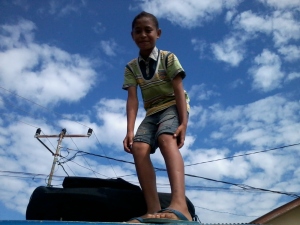




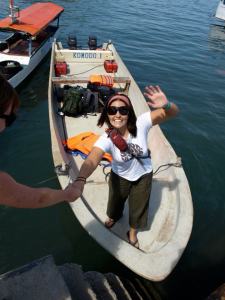

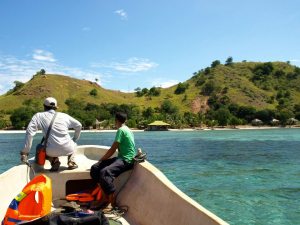


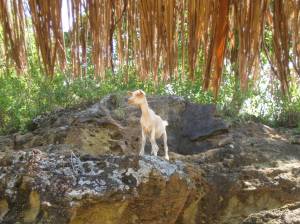


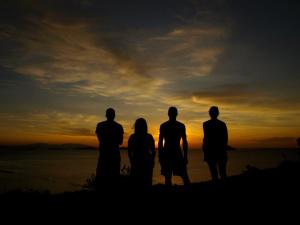





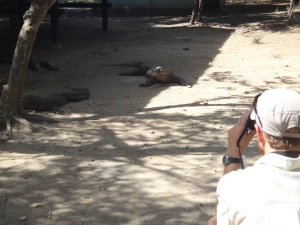
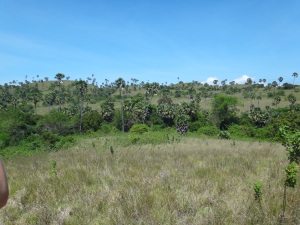

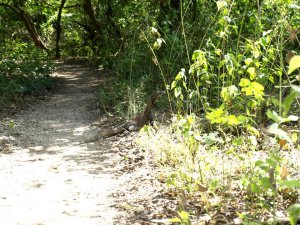

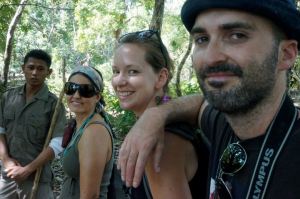
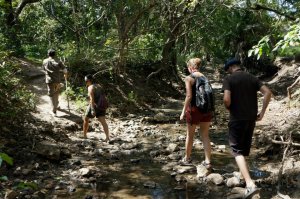



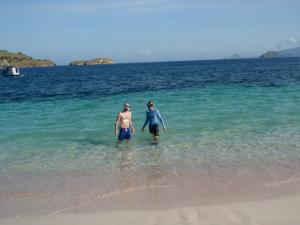




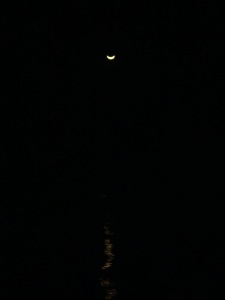

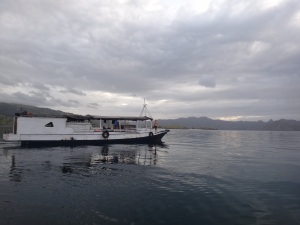


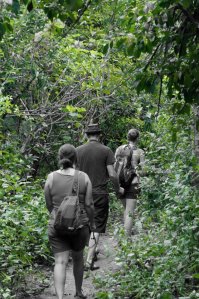


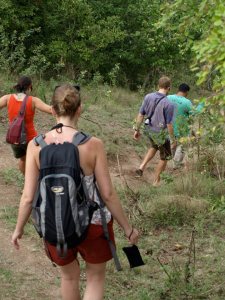
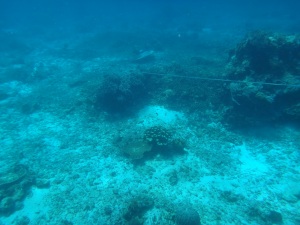






Like Hemingway said about Paris, you will have these places and voyages with you always.
You’re right. This place is my moveable feast. Thank you, Pat.
WOW!! You made me feel there–places I probably would have been terrified to actually BE!! JJ and Em will never forget your friendship and these other worldly experiences! You are putting your writing to good use!
Thanks for the support, Jana. Traveling with them was really spectacular; together we were able to discover my favorite part of Indonesia. Amazing!